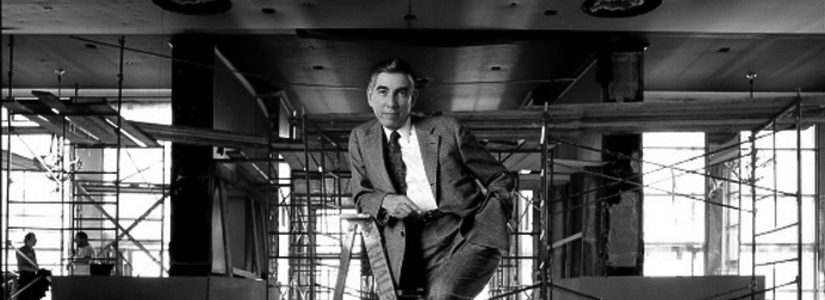
In Memoriam: Hugh Hardy
October 9, 2017 | by John Reddick, Archive Project board member and Harlem historian
Article from Fall 2017 Newsletter
I was sorry to hear the sad news of Hugh Hardy’s passing. I had a chance to work with him and his firm in the design development for the Harlem Gateway at 110th Street and Frederick Douglass Circle projects. He always had gifted insights and was delightful to be with. As it turned out, his firm was also involved in several other Harlem projects, including the studios for Dance Theatre of Harlem, where he set an image of its founder Arthur Mitchell as an ever-dancing weathervane on its roof. On 125th Street he designed the Marshall’s store building, where he thoughtfully worked an African fabric pattern into the façade’s brickwork. Even today it remains, in solo, the most thoughtful edifice in the wave of speculator-driven commercial development on 125th Street.
Decades earlier however, his interest in theater and the “happenings” of the 1960s brought his design talents to Harlem for the rehabilitation of a theater space in the old Renaissance Casino complex for the innovative New Lafayette Theatre group. These African-American playwrights and actors of the 1960s and ’70s were in the forefront of the era’s radical Black theater movement. Hardy designed for them a great space decades before his talents brought similar expression and an appreciation of designing on a limited budget to the renovation of the Joyce Theater in Chelsea. Hardy would go on to reshape New York’s cultural landscape through design during his 50-year career, with work recognized for an enlightened spirit and a sensitive response to context. He was involved with projects for the Brooklyn Academy of Music and the renovation of Radio City Music Hall. His restorations of the New Victory and New Amsterdam theaters, among other projects along 42nd Street, were pivotal in the revitalization of New York City’s Theater Row.
In this way, Hugh’s theatrical personality will live on, not just in our memory, but in that of future generations who experience his mastery of the drama in architecture and its support and enhancement of the theatrical experience. In that spirit he gave every New York community where he was called to serve a full and equal measure of his talents. For that, we owe Hugh many thanks.


